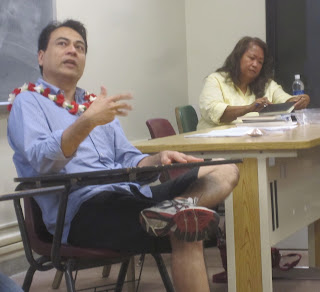manatee
graveyard
phalanges
pie
Paris
zombie
And here is the sestina I wrote. I feel very sheepish in noting that I've never before written a sestina. But what fun!
Manatees & Zombies in a Parisian Graveyard
A horrible, hot Florida vacation. All I saw was a manatee
who lolled in the rancid water like a zombie
trolling around a 19th century graveyard,
all the bodies decayed, except for some stray phalanges--
is that a word you'd use in Paris,
I wondered, when you're asked for tart, or pie?
We drove past Pres. Nixon's favorite bakery for key lime pie
still seeing in our mind's eye the bulbous manatee
wearing a whisker as stylish as any Paris
haberdasher sews, the slow-moving zombie
drifting among fans of hands wearing their phalanages
underneath gloves as gray as any graveyard
when, through the hard rain, we spied a graveyard
and decided it was just the place to eat our pie,
taking care to keep clean our smudged phalanges
lest they get lost like dice, like a manatee
that earned a big prize as Zombie
of the Month at a prime cafe in Paris--
I do so miss the Spring in gay Paris,
Oscar Wilde and Jim Morrison in Pere Lachaise graveyard.
Pedestrians near the Eiffel Tower look like zombies
out in search of a proverbial pie
made of cherries, apples, strawberries, or manatee
jam that really stickies your phalanges.
You! with the oddly bent phalanges,
your arthritic hands like a bare tree in Paris
that one winter we went from manatee
to zabronkey in the dictionary's graveyard,
slowing down only once for pie
and a hard look at the word zombie.
Zombie Land's the new Disney, where Phalanges
who lolled in the rancid water like a zombie
trolling around a 19th century graveyard,
all the bodies decayed, except for some stray phalanges--
is that a word you'd use in Paris,
I wondered, when you're asked for tart, or pie?
We drove past Pres. Nixon's favorite bakery for key lime pie
still seeing in our mind's eye the bulbous manatee
wearing a whisker as stylish as any Paris
haberdasher sews, the slow-moving zombie
drifting among fans of hands wearing their phalanages
underneath gloves as gray as any graveyard
when, through the hard rain, we spied a graveyard
and decided it was just the place to eat our pie,
taking care to keep clean our smudged phalanges
lest they get lost like dice, like a manatee
that earned a big prize as Zombie
of the Month at a prime cafe in Paris--
I do so miss the Spring in gay Paris,
Oscar Wilde and Jim Morrison in Pere Lachaise graveyard.
Pedestrians near the Eiffel Tower look like zombies
out in search of a proverbial pie
made of cherries, apples, strawberries, or manatee
jam that really stickies your phalanges.
You! with the oddly bent phalanges,
your arthritic hands like a bare tree in Paris
that one winter we went from manatee
to zabronkey in the dictionary's graveyard,
slowing down only once for pie
and a hard look at the word zombie.
Zombie Land's the new Disney, where Phalanges
is a rollercoaster ride, the Pie a bird in Paris, and climate
change a graveyard for my late pet, Manatee.
I'm not sure my last three lines follow the directions very well, but there you have it.







